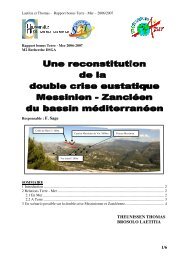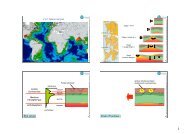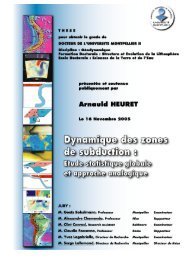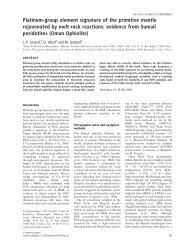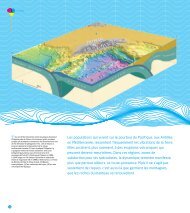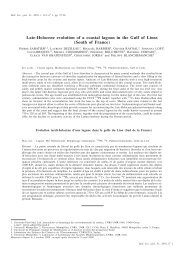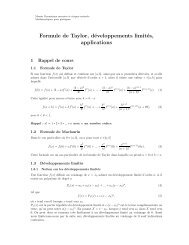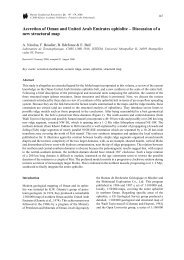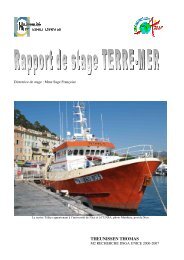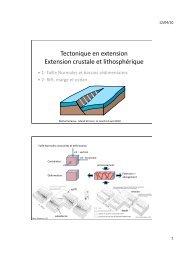Géochronologie U-Pb par ablation laser et ICP-MS (LA-ICP-MS ...
Géochronologie U-Pb par ablation laser et ICP-MS (LA-ICP-MS ...
Géochronologie U-Pb par ablation laser et ICP-MS (LA-ICP-MS ...
You also want an ePaper? Increase the reach of your titles
YUMPU automatically turns print PDFs into web optimized ePapers that Google loves.
Vol. 25 — N° 2-3<br />
12<br />
01<br />
p.361-373<br />
GEOSTANDARDS<br />
NEWSLETTER<br />
The Journal of Geostandards and Geoanalysis<br />
Evaluation of <strong>Pb</strong>-<strong>Pb</strong> and U-<strong>Pb</strong> Laser Ablation <strong>ICP</strong>-<strong>MS</strong><br />
Zircon Dating using Matrix-Matched Calibration Samples<br />
with a Frequency Quadrupled (266 nm) Nd-YAG Laser<br />
Olivier Bruguier (1)*, Philippe Télouk (2), Alain Cocherie (3),<br />
Anne-Marie Fouillac (3) and Francis Albarède (2)<br />
(1) ISTEEM-CNRS, Service <strong>ICP</strong>-<strong>MS</strong>, cc 049, Université de Montpellier II, Place E. Bataillon, 34095 Montpellier, France.<br />
* Corresponding author, e-mail: bruguier@dstu.univ-montp2.fr<br />
(2) Laboratoire des Sciences de la Terre, Ecole Normale Supérieure de Lyon, 46 Allée d’Italie, 69364 Lyon Cedex 7, France<br />
(3) BRGM, 3 Avenue C. Guillemin, BP 6009, 45060 Orléans, France<br />
This paper reports the successful application of<br />
<strong>laser</strong> <strong>ablation</strong> (<strong>LA</strong>) <strong>ICP</strong>-<strong>MS</strong> to the in situ analysis of<br />
207<strong>Pb</strong>/ 206 <strong>Pb</strong> and 206 <strong>Pb</strong>/ 238 U isotopic ratios on<br />
zircon crystals using matrix-matched calibration<br />
samples as external calibrators. For 207 <strong>Pb</strong>/ 206 <strong>Pb</strong><br />
analyses, <strong>LA</strong>-<strong>ICP</strong>-<strong>MS</strong> results on reference materials<br />
(UQ-Z1 and G91500) indicated individual precisions<br />
in the range 1-10% (2s), most analyses being b<strong>et</strong>ter<br />
than 6%. The resulting weighted means were<br />
associated with errors typically b<strong>et</strong>ter than 1% with<br />
ages of 1148 ± 5 Ma (2s) and 1069 ± 9 Ma (2s)<br />
respectively. Analyses of well-dated late Archaean<br />
granitic rocks from the western margin of the Yilgarn<br />
Craton (Australia) are presented and show a close<br />
agreement with the reference values. An orthogneiss<br />
dated at 2662 ± 4 Ma (2s) by ion microprobe<br />
(SHRIMP) gave a 207 <strong>Pb</strong>/ 206 <strong>Pb</strong> age of 2657 ± 6 Ma<br />
(2s). A more complex zircon population from a<br />
syenite emplaced at 2654 ± 5 Ma containing a<br />
≤ 3.25 Ga inherited component has been<br />
investigated using a spot size of approximately 45<br />
µm. <strong>LA</strong>-<strong>ICP</strong>-<strong>MS</strong> provides a 207 <strong>Pb</strong>/ 206 <strong>Pb</strong> age of 2653<br />
± 6 Ma with older grains yielding ages of up to<br />
3.23 Ga. Dating of younger rocks (< 1 Ga), however,<br />
was limited by poor precision in the measurement of<br />
the 207 <strong>Pb</strong>/ 206 <strong>Pb</strong> isotopic ratios and by inter-element<br />
fractionation b<strong>et</strong>ween <strong>Pb</strong> and U during the <strong>ablation</strong><br />
processes. Using a high power density, variations of<br />
the 206 <strong>Pb</strong>/ 238 U ratios during one spot analysis<br />
appeared to correlate positively with time over<br />
the first minute of <strong>ablation</strong>. A linear fit of the data<br />
acquired during this period allowed a 206 <strong>Pb</strong>/ 238 U<br />
ratio to be calculated, thus reducing the magnitude<br />
of the fractionation and improving precision to<br />
around 5% (2s). Results on the G91500 zircon<br />
C<strong>et</strong> article présente l’application de la technique<br />
d’<strong>ablation</strong> <strong>laser</strong> <strong>par</strong> <strong>ICP</strong>-<strong>MS</strong> à l’analyse in situ des<br />
rapports isotopiques 207 <strong>Pb</strong>/ 206 <strong>Pb</strong> <strong>et</strong> 206 <strong>Pb</strong>/ 238 U sur<br />
cristaux de zircons en utilisant un matériel de<br />
référence de matrice identique. Pour les analyses<br />
207<strong>Pb</strong>/ 206 <strong>Pb</strong>, les résultats des expériences d’<strong>ablation</strong><br />
<strong>laser</strong> sur zircons gemmes (UQ-Z1 <strong>et</strong> G91500)<br />
fournissent des précisions analytiques de l’ordre<br />
de 1 à 10% (2s) , la plu<strong>par</strong>t des analyses étant<br />
meilleures que 6% (2s). Les moyennes pondérées<br />
fournissent des erreurs typiques de l’ordre de 1%<br />
avec des âges de 1148 ± 5 Ma (2s) <strong>et</strong> 1069 ± 9 Ma<br />
(2s) respectivement. Les résultats obtenus sur des<br />
granitoïdes Archéens d’âge connu affleurant sur<br />
la bordure Ouest du Craton du Yilgarn (Australie<br />
Occidentale) sont présentés <strong>et</strong> sont en bon accord<br />
avec les valeurs de référence. Un orthogneiss, daté<br />
à 2662 ± 4 Ma (2s) <strong>par</strong> sonde ionique (SHRIMP),<br />
fournit un âge 207 <strong>Pb</strong>/ 206 <strong>Pb</strong> de 2657 ± 6 Ma (2s).<br />
Une syénite, mise en place à 2654 ± 5 Ma (2s) <strong>et</strong><br />
présentant une population de zircon plus complexe<br />
avec un héritage ancien pouvant atteindre 3.25 Ga<br />
a été datée <strong>par</strong> <strong>ablation</strong> <strong>laser</strong> à 2653 ± 6 Ma (2s).<br />
Des âges plus anciens, pouvant atteindre 3.23 Ga,<br />
ont également été reconnus sur des cœurs hérités.<br />
L’application à des roches plus récentes (< 1 Ga) est<br />
cependant limitée <strong>par</strong> la faible précision dans la<br />
mesure des rapports isotopiques 207 <strong>Pb</strong>/ 206 <strong>Pb</strong> <strong>et</strong> <strong>par</strong><br />
un fractionnement inter élémentaire important entre<br />
le <strong>Pb</strong> <strong>et</strong> l’U durant le processus d’<strong>ablation</strong>. En<br />
utilisant une puissance importante, la variation des<br />
rapports 206 <strong>Pb</strong>/ 238 U présente une corrélation linéaire<br />
avec le temps durant la première minute d’analyse.<br />
Une régression des données obtenues durant c<strong>et</strong><br />
intervalle perm<strong>et</strong> de calculer le rapport 206 <strong>Pb</strong>/ 238 U<br />
361<br />
Received 10 Nov 00 — Accepted 04 Jun 01



